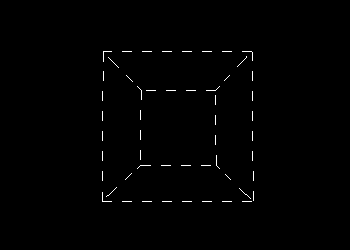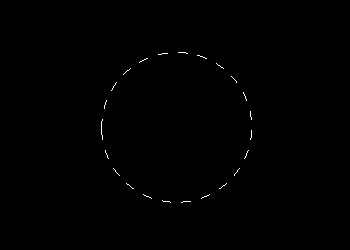graphics-snippets
Dashed lines with OpenGL core profile
The following is the answer to the StackOverflow question Dashed line in OpenGL3?
Dashed line segments
For separate line segments, this is not very complicated at all. For example drawing the GL_LINES primitives.
The trick is to know the start of the line segment in the fragment shader. This easy by using a flat interpolation qualifier.
The vertex shader has to pass the normalized device coordinate to the fragment shader. Once with default interpolation and once with no (flat) interpolation. This causes that in the fragment shade, the first input parameter contains the NDC coordinate of the actual position on the line and the later the NDC coordinate of the start of the line.
#version 330
layout (location = 0) in vec3 inPos;
flat out vec3 startPos;
out vec3 vertPos;
uniform mat4 u_mvp;
void main()
{
vec4 pos = u_mvp * vec4(inPos, 1.0);
gl_Position = pos;
vertPos = pos.xyz / pos.w;
startPos = vertPos;
}
Additionally the varying inputs, the fragment shader has uniform variables. u_resolution contains the width and the height of the viewport. u_dashSize contains the length of line and u_gapSize the length of a gap in pixel.
So the length of the line from the start to the actual fragment can be calculated:
vec2 dir = (vertPos.xy-startPos.xy) * u_resolution/2.0;
float dist = length(dir);
And fragment on the gab can be discarded, by the discard command.
if (fract(dist / (u_dashSize + u_gapSize)) > u_dashSize/(u_dashSize + u_gapSize))
discard;
Fragment shader:
#version 330
flat in vec3 startPos;
in vec3 vertPos;
out vec4 fragColor;
uniform vec2 u_resolution;
uniform float u_dashSize;
uniform float u_gapSize;
void main()
{
vec2 dir = (vertPos.xy-startPos.xy) * u_resolution/2.0;
float dist = length(dir);
if (fract(dist / (u_dashSize + u_gapSize)) > u_dashSize/(u_dashSize + u_gapSize))
discard;
fragColor = vec4(1.0);
}
For the following simple demo program I’ve used the GLFW API for creating a window, GLEW for loading OpenGL and GLM -OpenGL Mathematics for the math. I don’t provide the code for the function CreateProgram, which just creates a program object, from the vertex shader and fragment shader source code:

#include <GL/glew.h>
#include <GL/gl.h>
#include <glm/glm.hpp>
#include <glm/gtc/matrix_transform.hpp>
#include <glm/gtc/type_ptr.hpp>
#include <GLFW/glfw3.h>
#include <vector>
#define _USE_MATH_DEFINES
#include <math.h>
int main(void)
{
if (glfwInit() == GLFW_FALSE)
return 0;
GLFWwindow *window = glfwCreateWindow(400, 300, "OGL window", nullptr, nullptr);
if (window == nullptr)
return 0;
glfwMakeContextCurrent(window);
glewExperimental = true;
if (glewInit() != GLEW_OK)
return 0;
GLuint program = CreateProgram(vertShader, fragShader);
GLint loc_mvp = glGetUniformLocation(program, "u_mvp");
GLint loc_res = glGetUniformLocation(program, "u_resolution");
GLint loc_dash = glGetUniformLocation(program, "u_dashSize");
GLint loc_gap = glGetUniformLocation(program, "u_gapSize");
glUseProgram(program);
glUniform1f(loc_dash, 10.0f);
glUniform1f(loc_gap, 10.0f);
std::vector<float> varray{
-1, -1, -1, 1, -1, -1, 1, 1, -1, -1, 1, -1,
-1, -1, 1, 1, -1, 1, 1, 1, 1, -1, 1, 1
};
std::vector<unsigned int> iarray{
0, 1, 1, 2, 2, 3, 3, 0,
4, 5, 5, 6, 6, 7, 7, 4,
0, 4, 1, 5, 2, 6, 3, 7
};
GLuint bo[2], vao;
glGenBuffers(2, bo);
glGenVertexArrays(1, &vao);
glBindVertexArray(vao);
glEnableVertexAttribArray(0);
glBindBuffer(GL_ARRAY_BUFFER, bo[0] );
glBufferData(GL_ARRAY_BUFFER, varray.size()*sizeof(*varray.data()), varray.data(), GL_STATIC_DRAW);
glVertexAttribPointer(0, 3, GL_FLOAT, GL_FALSE, 0, 0);
glBindBuffer(GL_ELEMENT_ARRAY_BUFFER, bo[1]);
glBufferData(GL_ELEMENT_ARRAY_BUFFER, iarray.size()*sizeof(*iarray.data()), iarray.data(), GL_STATIC_DRAW);
glClearColor(0.0f, 0.0f, 0.0f, 0.0f);
glm::mat4 view = glm::lookAt(glm::vec3(0.0f, 0.0f, 5.0f), glm::vec3(0.0f, 0.0f, 0.0f), glm::vec3(0.0f, 1.0f, 0.0f));
glm::mat4 project;
int vpSize[2]{0, 0};
while (!glfwWindowShouldClose(window))
{
int w, h;
glfwGetFramebufferSize(window, &w, &h);
if (w != vpSize[0] || h != vpSize[1])
{
vpSize[0] = w; vpSize[1] = h;
glViewport(0, 0, vpSize[0], vpSize[1]);
project = glm::perspective(glm::radians(90.0f), (float)w/(float)h, 0.1f, 10.0f);
glUniform2f(loc_res, (float)w, (float)h);
}
static float angle = 1.0f;
glm::mat4 modelview( 1.0f );
modelview = glm::translate(modelview, glm::vec3(0.0f, 0.0f, -3.0f) );
modelview = glm::rotate(modelview, glm::radians(angle), glm::vec3(1.0f, 0.0f, 0.0f));
modelview = glm::rotate(modelview, glm::radians(angle*0.5f), glm::vec3(0.0f, 1.0f, 0.0f));
angle += 0.5f;
glm::mat4 mvp = project * modelview;
glUniformMatrix4fv(loc_mvp, 1, GL_FALSE, glm::value_ptr(mvp));
glClear(GL_COLOR_BUFFER_BIT);
glDrawElements(GL_LINES, (GLsizei)iarray.size(), GL_UNSIGNED_INT, nullptr);
glfwSwapBuffers(window);
glfwPollEvents();
}
glfwTerminate();
return 0;
}
Dashed line strips
Things get a bit more complicated, if the goal is to draw a dashed line along a polygon. For example drawing a GL_LINE_STRIP primitive.
The length of the line cannot be calculated in the shader program, without knowing all the primitives of the line. Even if all the primitives would be known (e.g. SSBO), then the calculation would have to be done in a loop.
I decided to add an additional attribute to the shader program, which contains the “distance” from the start of the line to the vertex coordinate. By “distance” is meant the length of the projected polygon on to the viewport.
This causes that the vertex shader and fragment shader is even simpler:
Vertex shader:
#version 330
layout (location = 0) in vec3 inPos;
layout (location = 1) in float inDist;
out float dist;
uniform mat4 u_mvp;
void main()
{
dist = inDist;
gl_Position = u_mvp * vec4(inPos, 1.0);
}
Fragment shader:
#version 330
in float dist;
out vec4 fragColor;
uniform vec2 u_resolution;
uniform float u_dashSize;
uniform float u_gapSize;
void main()
{
if (fract(dist / (u_dashSize + u_gapSize)) > u_dashSize/(u_dashSize + u_gapSize))
discard;
fragColor = vec4(1.0);
}
In the demo program the inDist attribute is calculated on the CPU. Each vertex coordinate is transformed by the model, view, projection matrix. Finally it is transformed from normalized device space to window space. The XY distance between adjacent coordinates of the line strip is calculated and the lengths are summed along the line strip and assigned to the corresponding attribute value:
int w = [...], h = [...]; // window widht and height
glm::mat4 mpv = [...]; // model view projection matrix
std::vector<glm::vec3> varray{ [...] }; // array of vertex
std::vector<float> darray(varray.size(), 0.0f); // distance attribute - has to be computed
glm::mat4 wndmat = glm::scale(glm::mat4(1.0f), glm::vec3((float)w/2.0f, (float)h/2.0f, 1.0f));
wndmat = glm::translate(wndmat, glm::vec3(1.0f, 1.0f, 0.0f));
glm::vec2 vpPt(0.0f, 0.0f);
float dist = 0.0f;
for (size_t i=0; i < varray.size(); ++i)
{
darray[i] = dist;
glm::vec4 clip = mvp * glm::vec4(varray[i], 1.0f);
glm::vec4 ndc = clip / clip.w;
glm::vec4 vpC = wndmat * ndc;
float len = i==0 ? 0.0f : glm::length(vpPt - glm::vec2(vpC));
vpPt = glm::vec2(vpC);
dist += len;
}
Demo program:

int main(void)
{
if (glfwInit() == GLFW_FALSE)
return 0;
GLFWwindow *window = glfwCreateWindow(800, 600, "OGL window", nullptr, nullptr);
if (window == nullptr)
return 0;
glfwMakeContextCurrent(window);
glewExperimental = true;
if (glewInit() != GLEW_OK)
return 0;
GLuint program = CreateProgram(vertShader, fragShader);
GLint loc_mvp = glGetUniformLocation(program, "u_mvp");
GLint loc_res = glGetUniformLocation(program, "u_resolution");
GLint loc_dash = glGetUniformLocation(program, "u_dashSize");
GLint loc_gap = glGetUniformLocation(program, "u_gapSize");
glUseProgram(program);
glUniform1f(loc_dash, 10.0f);
glUniform1f(loc_gap, 10.0f);
std::vector<glm::vec3> varray;
for (size_t u=0; u <= 360; ++u)
{
double a = u*M_PI/180.0;
double c = cos(a), s = sin(a);
varray.emplace_back(glm::vec3((float)c, (float)s, 0.0f));
}
std::vector<float> darray(varray.size(), 0.0f);
GLuint bo[2], vao;
glGenBuffers(2, bo);
glGenVertexArrays(1, &vao);
glBindVertexArray(vao);
glEnableVertexAttribArray(0);
glEnableVertexAttribArray(1);
glBindBuffer(GL_ARRAY_BUFFER, bo[0] );
glBufferData(GL_ARRAY_BUFFER, varray.size()*sizeof(*varray.data()), varray.data(), GL_STATIC_DRAW);
glVertexAttribPointer(0, 3, GL_FLOAT, GL_FALSE, 0, 0);
glBindBuffer(GL_ARRAY_BUFFER, bo[1] );
glBufferData(GL_ARRAY_BUFFER, darray.size()*sizeof(*darray.data()), darray.data(), GL_STATIC_DRAW);
glVertexAttribPointer(1, 1, GL_FLOAT, GL_FALSE, 0, 0);
glClearColor(0.0f, 0.0f, 0.0f, 0.0f);
glm::mat4 view = glm::lookAt(glm::vec3(0.0f, 0.0f, 5.0f), glm::vec3(0.0f, 0.0f, 0.0f), glm::vec3(0.0f, 1.0f, 0.0f));
glm::mat4 project, wndmat;
int vpSize[2]{0, 0};
while (!glfwWindowShouldClose(window))
{
int w, h;
glfwGetFramebufferSize(window, &w, &h);
if (w != vpSize[0] || h != vpSize[1])
{
vpSize[0] = w; vpSize[1] = h;
glViewport(0, 0, vpSize[0], vpSize[1]);
project = glm::perspective(glm::radians(90.0f), (float)w/(float)h, 0.1f, 10.0f);
glUniform2f(loc_res, (float)w, (float)h);
wndmat = glm::scale(glm::mat4(1.0f), glm::vec3((float)w/2.0f, (float)h/2.0f, 1.0f));
wndmat = glm::translate(wndmat, glm::vec3(1.0f, 1.0f, 0.0f));
}
static float angle = 1.0f;
glm::mat4 modelview( 1.0f );
modelview = glm::translate(modelview, glm::vec3(0.0f, 0.0f, -2.0f) );
modelview = glm::rotate(modelview, glm::radians(angle), glm::vec3(1.0f, 0.0f, 0.0f));
modelview = glm::rotate(modelview, glm::radians(angle*0.5f), glm::vec3(0.0f, 1.0f, 0.0f));
angle += 0.5f;
glm::mat4 mvp = project * modelview;
glm::vec2 vpPt(0.0f, 0.0f);
float dist = 0.0f;
for (size_t i=0; i < varray.size(); ++i)
{
darray[i] = dist;
glm::vec4 clip = mvp * glm::vec4(varray[i], 1.0f);
glm::vec4 ndc = clip / clip.w;
glm::vec4 vpC = wndmat * ndc;
float len = i==0 ? 0.0f : glm::length(vpPt - glm::vec2(vpC));
vpPt = glm::vec2(vpC);
dist += len;
}
glBufferSubData(GL_ARRAY_BUFFER, 0, darray.size()*sizeof(*darray.data()), darray.data());
glUniformMatrix4fv(loc_mvp, 1, GL_FALSE, glm::value_ptr(mvp));
glClear(GL_COLOR_BUFFER_BIT);
glDrawArrays(GL_LINE_STRIP, 0, (GLsizei)varray.size());
glfwSwapBuffers(window);
glfwPollEvents();
}
glfwTerminate();
return 0;
}
